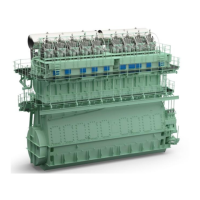Operation
0515−1/A1
Winterthur Gas & Diesel Ltd.
7/ 8
3.3.4 Injection Control Unit
The fuel injection must be cut out immediately if:
D The injection control unit has cracks
D The injection control valve or fuel quantity piston cannot move.
Note: When the injection is cut out (Inj. CUT OFF) you can can only operate the
engine at decreased load.
1) Replace the defective injection control unit as soon as possible. See the data in:
a) 0510−1, paragraph 2
b) 5564−1 in the Maintenance Manual.
3.3.5 Injection Pipe
1) If an injection pipe is broken, cut out the injection to the injection valves (see
0510−1 Cut out the injection, paragraph 1).
2) Replace the defective injection pipe as soon as possible. See the data in:
a) 0510−1 Replace the defective injection pipe, paragraph 2.2
b) 8733−1 Fuel Pressure Piping in the Maintenance Manual.
4. Defective Fuel Pressure Control Valve
4.1 Fault Identification
Fault identification of a defective pressure control valve (PCV) is as follows:
D The engine load decreases or the engine stops.
D The fuel rail pressure is too low (alarm).
D The regulating shaft position is higher than usual or at maximum.
D You can hear unusual noises when the engine operates.
4.2 Causes
D The retaining pressure is set too low, i.e. the knurled screw (4) is not at the
bottom stop (see Fig. 4).
D The fuel pressure control valve (2) is defective.
D The fuel pressure control valve (2) has opened or has a leak.
Note: If the knurled screw (4) is at the bottom stop and fuel drains from the fuel
pressure control valve, there is an indication of an internal leak.
2014
Faults in High Pressure Fuel System

